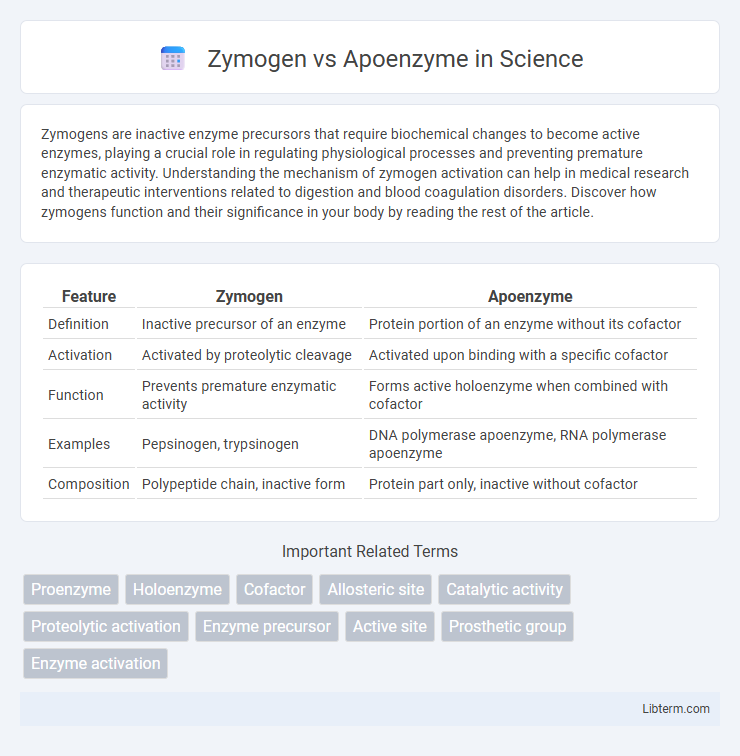Zymogens are inactive enzyme precursors that require biochemical changes to become active enzymes, playing a crucial role in regulating physiological processes and preventing premature enzymatic activity. Understanding the mechanism of zymogen activation can help in medical research and therapeutic interventions related to digestion and blood coagulation disorders. Discover how zymogens function and their significance in your body by reading the rest of the article.
Table of Comparison
| Feature | Zymogen | Apoenzyme |
|---|---|---|
| Definition | Inactive precursor of an enzyme | Protein portion of an enzyme without its cofactor |
| Activation | Activated by proteolytic cleavage | Activated upon binding with a specific cofactor |
| Function | Prevents premature enzymatic activity | Forms active holoenzyme when combined with cofactor |
| Examples | Pepsinogen, trypsinogen | DNA polymerase apoenzyme, RNA polymerase apoenzyme |
| Composition | Polypeptide chain, inactive form | Protein part only, inactive without cofactor |
Introduction to Zymogen and Apoenzyme
Zymogens, also known as proenzymes, are inactive enzyme precursors that require biochemical modification to become active enzymes, playing a critical role in regulating physiological processes such as digestion and blood coagulation. Apoenzymes represent the protein component of enzymes, lacking their necessary cofactor or coenzyme, making them catalytically inactive until the cofactor binds to form the active holoenzyme. Understanding the distinction between zymogens and apoenzymes is essential for elucidating enzyme activation mechanisms and their biological functions.
Definition of Zymogen
A zymogen, also known as a proenzyme, is an inactive precursor of an enzyme that requires a biochemical change to become catalytically active. Unlike apoenzymes, which are inactive proteins requiring a cofactor to function, zymogens undergo specific proteolytic cleavage to achieve their active enzyme form. This activation mechanism ensures precise regulation of enzymatic activity, critical in processes like digestion and blood coagulation.
Definition of Apoenzyme
An apoenzyme is the protein portion of an enzyme that requires a cofactor or coenzyme to become catalytically active. It remains inactive on its own until combined with the necessary non-protein molecule, while a zymogen is an inactive precursor enzyme that requires proteolytic cleavage for activation. The distinction highlights that apoenzymes depend on cofactors for functionality, whereas zymogens depend on structural modification.
Structural Differences Between Zymogen and Apoenzyme
Zymogens possess an inactive precursor structure containing additional peptide segments that block the active site, preventing enzymatic activity until cleavage activates the enzyme. In contrast, apoenzymes are the protein component of enzymes lacking their necessary cofactors or prosthetic groups, structurally complete but functionally inactive without these non-protein molecules. The key structural difference lies in zymogens having inhibitory pro-sequences, whereas apoenzymes are fully folded proteins awaiting cofactor binding for catalytic activity.
Functional Roles in Biochemical Processes
Zymogens serve as inactive precursors that prevent premature enzymatic activity, ensuring regulation and protection within biochemical pathways. Apoenzymes represent the protein component of enzymes requiring cofactor binding to become catalytically active, playing a critical role in substrate specificity and enzymatic function. The transition from zymogen to active enzyme involves specific cleavage, while apoenzymes depend on cofactor association for their functional roles in metabolism and cellular regulation.
Activation Mechanisms: Zymogen vs Apoenzyme
Zymogens require specific proteolytic cleavage to become active enzymes, where an inactive precursor is converted by the removal of an inhibitory peptide segment. Apoenzymes are inactive protein forms that achieve catalytic activity only after binding with a necessary cofactor or coenzyme, enabling the conformational changes needed for function. The activation of zymogens depends on irreversible proteolysis, whereas apoenzyme activation involves reversible non-covalent interactions with cofactors.
Examples of Zymogens in Biological Systems
Zymogens, also known as proenzymes, are inactive precursors of enzymes that require biochemical alteration to become active. Common examples of zymogens include pepsinogen, which converts to pepsin in the stomach for protein digestion, and trypsinogen, which activates into trypsin in the pancreas to aid in proteolysis. Apoenzymes differ by being the inactive protein portion of enzymes that need a cofactor to become catalytically active.
Examples of Apoenzymes in Metabolic Pathways
Apoenzymes serve as the inactive protein components of enzymes, requiring cofactors or coenzymes for activation, with examples such as hexokinase in glycolysis and DNA polymerase in DNA replication. These apoenzymes play crucial roles in metabolic pathways by facilitating substrate binding and catalysis once the necessary non-protein molecules bind. Their activation controls key biochemical processes, influencing energy production and genetic information flow.
Regulatory Importance in Enzyme Activity
Zymogens, also known as proenzymes, play a crucial regulatory role in controlling enzyme activity by remaining inactive until specific physiological conditions or proteolytic cleavage activate them, preventing premature or uncontrolled reactions. Apoenzymes are the protein components of enzymes that require the binding of cofactors or coenzymes to become catalytically active, ensuring enzyme activation only in the presence of necessary molecules. This precise regulation through zymogen activation and apoenzyme cofactor dependence maintains metabolic balance and prevents cellular damage.
Clinical and Industrial Relevance
Zymogens, inactive enzyme precursors, play a crucial role in clinical settings by allowing controlled activation of enzymes, minimizing tissue damage and improving therapeutic outcomes in conditions like pancreatitis and blood clotting disorders. Apoenzymes, the protein components of enzymes requiring cofactors, are vital for industrial biocatalysis, enabling precise modulation of enzyme activity in pharmaceutical manufacturing and bioprocessing. Understanding the functional differences between zymogens and apoenzymes enhances drug design and optimization of enzyme-based industrial applications.
Zymogen Infographic

 libterm.com
libterm.com